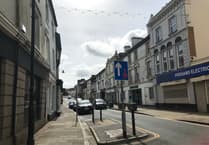THE path beside the Tavistock Canal is one of the favourite level walks in and around Tavistock, as it passes through such a beautiful part of the town and into the adjoining Lumburn Valley.
The canal originates just above the weir at Abbey Bridge, where water from the River Tavy is diverted into a feeder channel — an open section of which can be seen at the back of the Bedford Hotel gardens, behind their car park.
It is visible again at the footpath bridge entrance to the main Bedford public car park, where it runs along the northern edge.
The canal proper is first seen emerging under the Guide Hall at the far end of the Bedford car park.
This building was originally a granary, built over the canal, alongside the quay at Canal Road.
The adjacent buildings, which are now the Wharf Arts and Entertainment Centre, were originally a warehouse and offices for the canal business.
From this quay began the four and a half mile journey down to the inclined plane railway connecting Tavistock to the port at Morwellham on the River Tamar.
The quay was once the bustling site of nineteenth century industrial activity where cargoes of metal-bearing ores and slate, lime and agricultural produce were loaded and unloaded.
One of the cottages alongside the quay bears a plaque to John Taylor FRS, who spent twelve years in and around Tavistock.
John is best known locally as a 19th century mining entrepreneur and engineer, who managed the planning and building of the Tavistock Canal between 1803 and 1817. The canal was a solution to the problem of transporting copper ores from the mines at Mary Tavy on Dartmoor to the port at Morwellham and on to Plymouth via the River Tamar.
John had been appointed in 1798 as manager, or mine captain, of the Wheal Friendship mine at Mary Tavy.
This mine was then one of the largest producers of copper ore in Devon, an extraordinary responsibility for a 19-year-old.
However, John had been apprenticed to a civil engineer and surveyor in Norfolk and had received a very thorough education. His family had connections with the prosperous Martineau family of Norwich, who had invested in the Wheal Friendship mine at Mary Tavy.
Following a holiday in Devon with the Martineaus, John was offered the position at the Wheal Friendship mine.
The first of seven children, born in Norwich on August 22 1779, John was the son of a moderately prosperous textile manufacturer.
His mother Susannah had taken a particular interest in his education and encouraged interests in mathematics and engineering design. He was also encouraged to adhere to a strict moral code and to avoid debt.
This grounding must have helped John to become an astute financial manager of the many mines in which he had interests in later life.
While working at the Mary Tavy mines, he lived at Holwell House on Whitchurch Down near Tavistock, five miles from Mary Tavy. He married Ann Pring in 1805 and they had two sons, John and Richard and three daughters, Anne, Susan and Honora.
John Taylor's parents in Norwich had many connections through the Unitarian Church and varied social and intellectual interests.
They entertained some of the leading literary figures of the day, including Robert Southey, who became poet laureate and made a single visit to Tavistock at Christmas 1835 to visit Mrs Bray and her protégée poet and domestic servant, Mary Maria Colling.
Locally, John was a founder of the Tavistock Subscription Library in 1799 and of a Tavistock elementary school.
He was one of the most respected and influential men of science and business of his day. He was elected Fellow of the Royal Society in 1825 and in 1839 became a member of the Institute of Civil Engineers.
To build the Tavistock Canal, which links the unnavigable River Tavy at Tavistock to the port at Morwellham on the tidal River Tamar, he had to overcome many engineering challenges.
Although the canal is only three feet deep and 16 feet wide it had to cross the Lumburn Valley which required and aqueduct.
The canal also had to pass under Morwell Down, though a one-and-a-half mile tunnel, which was eventually completed in 1816. The tunnelling led to the discovery of more copper lodes and the establishment of a new mine at Wheal Crebor.
The final engineering problem of the route, to transport the cargo from the canal barges down the 227 feet from the end of the canal to the quay at Morwellham, was solved by an inclined plane railway.
John Taylor was a notable 19th century engineer, entrepreneur and educator with a reputation for honesty and trustworthiness.
He has left a lasting legacy in Tavistock with the canal, which is now a leisure resource in the Meadows.
l On Monday, October 27 at 11am, Dr Ann Pulsford and Andrew Thompson will be talking about his life and engineering achievements, followed by a guided walk along the canal.
Tickets are £5 (£4 for Friends of the Wharf) and include refreshments.


